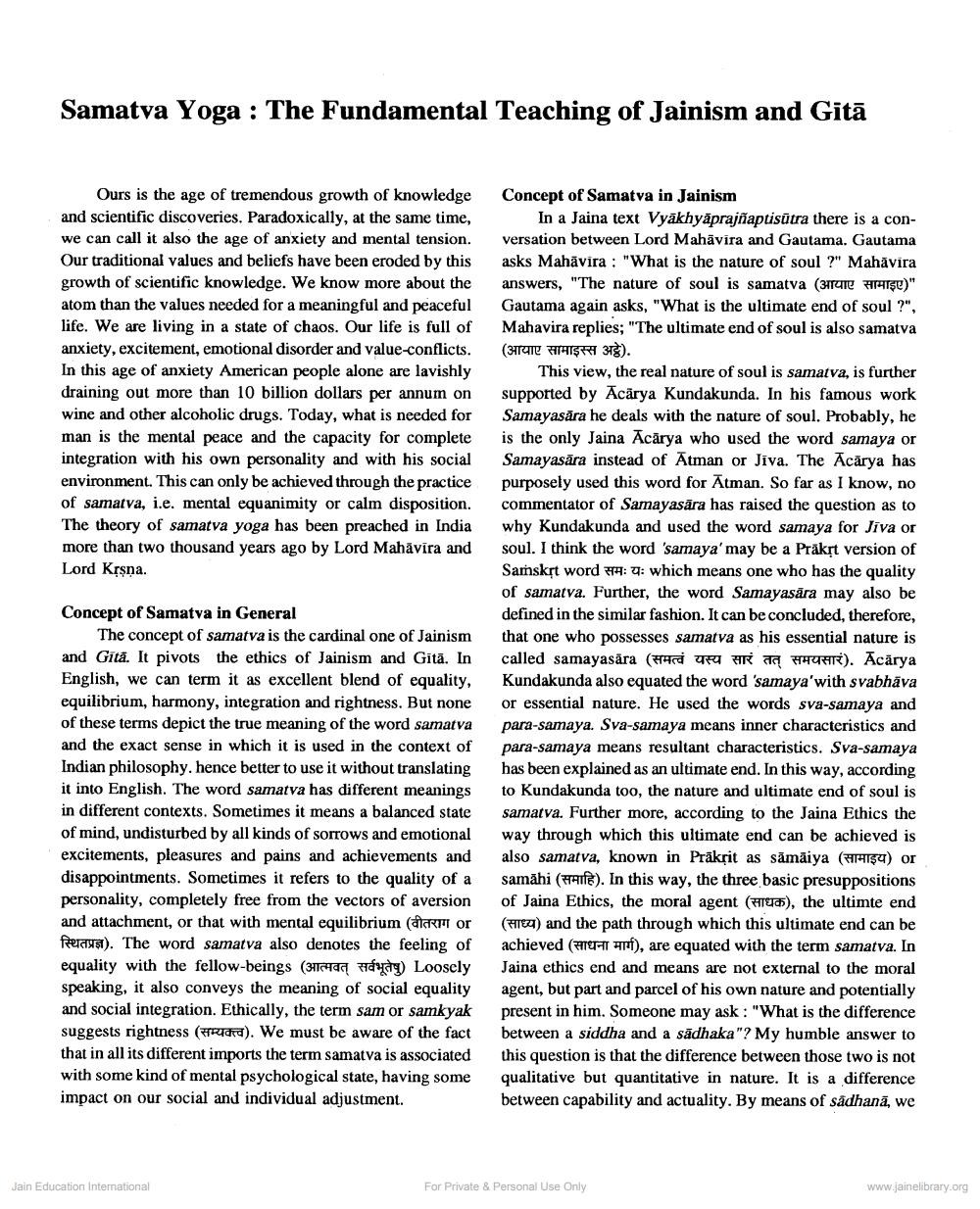________________
Samatva Yoga : The Fundamental Teaching of Jainism and Gitā
Ours is the age of tremendous growth of knowledge and scientific discoveries. Paradoxically, at the same time, we can call it also the age of anxiety and mental tension. Our traditional values and beliefs have been eroded by this growth of scientific knowledge. We know more about the atom than the values needed for a meaningful and peaceful life. We are living in a state of chaos. Our life is full of anxiety, excitement, emotional disorder and value-conflicts. In this age of anxiety American people alone are lavishly draining out more than 10 billion dollars per annum on wine and other alcoholic drugs. Today, what is needed for man is the mental peace and the capacity for complete integration with his own personality and with his social environment. This can only be achieved through the practice of samatva, i.e. mental equanimity or calm disposition. The theory of samatva yoga has been preached in India more than two thousand years ago by Lord Mahāvīra and Lord Krsna.
Concept of Samatva in General
The concept of samatva is the cardinal one of Jainism and Gitā. It pivots the ethics of Jainism and Gita. In English, we can term it as excellent blend of equality, equilibrium, harmony, integration and rightness. But none of these terms depict the true meaning of the word samatva and the exact sense in which it is used in the context of Indian philosophy. hence better to use it without translating it into English. The word samatva has different meanings in different contexts. Sometimes it means a balanced state of mind, undisturbed by all kinds of sorrows and emotional excitements, pleasures and pains and achievements and disappointments. Sometimes it refers to the quality of a personality, completely free from the vectors of aversion and attachment, or that with mental equilibrium (
am or Praust). The word samatva also denotes the feeling of equality with the fellow-beings (316L ) Loosely speaking, it also conveys the meaning of social equality and social integration. Ethically, the term sam or samkyak suggests rightness (Fra). We must be aware of the fact that in all its different imports the term samatva is associated with some kind of mental psychological state, having some impact on our social and individual adjustment.
Concept of Samatva in Jainism
In a Jaina text Vyākhyāprajñaptisūtra there is a conversation between Lord Mahavira and Gautama. Gautama asks Mahāvira : "What is the nature of soul ?" Mahavira answers, "The nature of soul is samatva (3HTUTE Fre)" Gautama again asks, "What is the ultimate end of soul ?", Mahavira replies; "The ultimate end of soul is also samatva (3114T HTHIRI 315).
This view, the real nature of soul is samatva, is further supported by Acårya Kundakunda. In his famous work Samayasăra he deals with the nature of soul. Probably, he is the only Jaina Acārya who used the word samaya or Samayasära instead of Atman or Jiva. The Ācārya has purposely used this word for Ātman. So far as I know, no commentator of Samayasāra has raised the question as to why Kundakunda and used the word samaya for Jiva or soul. I think the word 'samaya' may be a Präkst version of Samskrt word :: which means one who has the quality of samatva. Further, the word Samayasāra may also be defined in the similar fashion. It can be concluded, therefore, that one who possesses samat va as his essential nature is called samayasära (Herd U r T HUHT). Acārya Kundakunda also equated the word 'samaya'with svabhava or essential nature. He used the words sva-samaya and para-samaya. Sva-samaya means inner characteristics and para-samaya means resultant characteristics. Sva-samaya has been explained as an ultimate end. In this way, according to Kundakunda too, the nature and ultimate end of soul is samatva. Further more, according to the Jaina Ethics the way through which this ultimate end can be achieved is also samatva, known in Präkrit as sämäiya (ATHI5U) or samāhi (HAI). In this way, the three basic presuppositions of Jaina Ethics, the moral agent (HTC), the ultimte end (HTEY) and the path through which this ultimate end can be achieved (TEHT Erf), are equated with the term samatva. In Jaina ethics end and means are not external to the moral agent, but part and parcel of his own nature and potentially present in him. Someone may ask : "What is the difference between a siddha and a sādhaka"? My humble answer to this question is that the difference between those two is not qualitative but quantitative in nature. It is a difference between capability and actuality. By means of sadhanā, we
Jain Education International
For Private & Personal Use Only
www.jainelibrary.org




